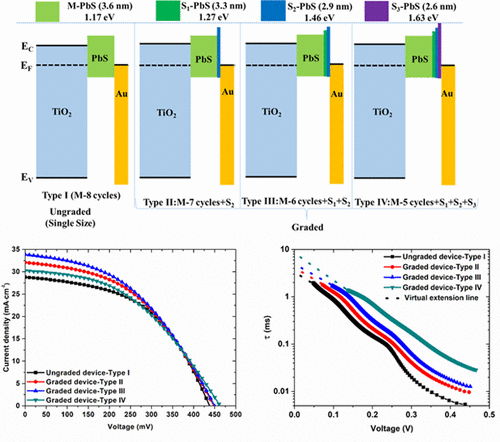当前位置:
X-MOL 学术
›
ACS Appl. Mater. Interfaces
›
论文详情
Our official English website, www.x-mol.net, welcomes your feedback! (Note: you will need to create a separate account there.)
Recombination Suppression in PbS Quantum Dot Heterojunction Solar Cells by Energy-Level Alignment in the Quantum Dot Active Layers
ACS Applied Materials & Interfaces ( IF 9.5 ) Pub Date : 2017-09-22 00:00:00 , DOI: 10.1021/acsami.7b06552 Chao Ding 1, 2 , Yaohong Zhang 1 , Feng Liu 1 , Naoki Nakazawa 1 , Qingxun Huang 1 , Shuzi Hayase 3, 4 , Yuhei Ogomi 3 , Taro Toyoda 1, 4 , Ruixiang Wang 5 , Qing Shen 1, 4
ACS Applied Materials & Interfaces ( IF 9.5 ) Pub Date : 2017-09-22 00:00:00 , DOI: 10.1021/acsami.7b06552 Chao Ding 1, 2 , Yaohong Zhang 1 , Feng Liu 1 , Naoki Nakazawa 1 , Qingxun Huang 1 , Shuzi Hayase 3, 4 , Yuhei Ogomi 3 , Taro Toyoda 1, 4 , Ruixiang Wang 5 , Qing Shen 1, 4
Affiliation

|
Using spatial energy-level gradient engineering with quantum dots (QDs) of different sizes to increase the generated carrier collection at the junction of a QD heterojunction solar cell (QDHSC) is a hopeful route for improving the energy-conversion efficiency. However, the results of current related research have shown that a variable band-gap structure in a QDHSC will create an appreciable increase, not in the illumination current density, but rather in the fill factor. In addition, there are a lack of studies on the mechanism of the effect of these graded structures on the photovoltaic performance of QDHSCs. This study presents the development of air atmosphere solution-processed TiO2/PbS QDs/Au QDHSCs by engineering the energy-level alignment (ELA) of the active layer via the use of a sorted order of differently sized QD layers (four QD sizes). In comparison to the ungraded device (without the ELA), the optimized graded architecture (containing the ELA) solar cells exhibited a great increase (21.4%) in short-circuit current density (Jsc). As a result, a Jsc value greater than 30 mA/cm2 has been realized in planar, thinner absorption layer (∼300 nm) PbS QDHSCs, and the open-circuit voltage (Voc) and power-conversion efficiency (PCE) were also improved. Through characterization by the light intensity dependences of the Jsc and Voc and transient photovoltage decay, we find that (i) the ELA structure, serving as an electron-blocking layer, reduces the interfacial recombination at the PbS/anode interface, and (ii) the ELA structure can drive more carriers toward the desirable collection electrode, and the additional carriers can fill the trap states, reducing the trap-assisted recombination in the PbS QDHSCs. This work has clearly elucidated the mechanism of the recombination suppression in the graded QDHSCs and demonstrated the effects of ELA structure on the improvement of Jsc. The charge recombination mechanisms characterized in this work would be able to shed light on further improvements of QDHSCs, which could even benefit other types of solar cells.
中文翻译:

PbS量子点异质结太阳能电池中通过能级对准量子点有源层中的重组抑制。
使用具有不同大小的量子点(QD)的空间能级梯度工程来增加QD异质结太阳能电池(QDHSC)的结处生成的载流子收集是提高能量转换效率的一条有希望的途径。但是,当前相关研究的结果表明,QDHSC中的可变带隙结构将产生明显的增加,而不是照明电流密度的增加,而是填充因子的增加。此外,关于这些渐变结构对QDHSCs光电性能影响机理的研究还很缺乏。这项研究提出了空气气氛溶液处理的TiO 2的发展/ PbS QDs / Au QDHSC,通过使用不同大小的QD层(四个QD大小)的排序顺序来设计有源层的能级排列(ELA)。与未分级设备(不含ELA)相比,优化的分级体系结构(包含ELA)太阳能电池的短路电流密度(J sc)大大提高(21.4%)。结果,在平面的,较薄的吸收层(约300 nm)的PbS QDHSCs中,实现了大于30 mA / cm 2的J sc值,并且开路电压(V oc)和功率转换效率(PCE)也得到了改善。通过表征J sc和V oc和瞬态光电压衰减,我们发现(i)作为电子阻挡层的ELA结构减少了PbS /阳极界面处的界面复合,并且(ii)ELA结构可以驱动更多的载流子流向所需的载流子收集电极,其他载流子可以填充陷阱状态,从而减少了PbS QDHSC中陷阱辅助的重组。这项工作清楚地阐明了分级QDHSCs中重组抑制的机理,并证明了ELA结构对J sc的改善的影响。这项工作中表征的电荷重组机制将能够阐明QDHSC的进一步改进,甚至可以使其他类型的太阳能电池受益。
更新日期:2017-09-23
中文翻译:

PbS量子点异质结太阳能电池中通过能级对准量子点有源层中的重组抑制。
使用具有不同大小的量子点(QD)的空间能级梯度工程来增加QD异质结太阳能电池(QDHSC)的结处生成的载流子收集是提高能量转换效率的一条有希望的途径。但是,当前相关研究的结果表明,QDHSC中的可变带隙结构将产生明显的增加,而不是照明电流密度的增加,而是填充因子的增加。此外,关于这些渐变结构对QDHSCs光电性能影响机理的研究还很缺乏。这项研究提出了空气气氛溶液处理的TiO 2的发展/ PbS QDs / Au QDHSC,通过使用不同大小的QD层(四个QD大小)的排序顺序来设计有源层的能级排列(ELA)。与未分级设备(不含ELA)相比,优化的分级体系结构(包含ELA)太阳能电池的短路电流密度(J sc)大大提高(21.4%)。结果,在平面的,较薄的吸收层(约300 nm)的PbS QDHSCs中,实现了大于30 mA / cm 2的J sc值,并且开路电压(V oc)和功率转换效率(PCE)也得到了改善。通过表征J sc和V oc和瞬态光电压衰减,我们发现(i)作为电子阻挡层的ELA结构减少了PbS /阳极界面处的界面复合,并且(ii)ELA结构可以驱动更多的载流子流向所需的载流子收集电极,其他载流子可以填充陷阱状态,从而减少了PbS QDHSC中陷阱辅助的重组。这项工作清楚地阐明了分级QDHSCs中重组抑制的机理,并证明了ELA结构对J sc的改善的影响。这项工作中表征的电荷重组机制将能够阐明QDHSC的进一步改进,甚至可以使其他类型的太阳能电池受益。


























 京公网安备 11010802027423号
京公网安备 11010802027423号